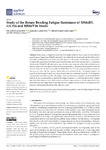Study of the Rotary Bending Fatigue Resistance of 30MnB5, 41CrS4 and 30MnVS6 Steels

Use este enlace para citar
http://hdl.handle.net/2183/30291Coleccións
- Investigación (EPEF) [590]
Metadatos
Mostrar o rexistro completo do ítemTítulo
Study of the Rotary Bending Fatigue Resistance of 30MnB5, 41CrS4 and 30MnVS6 SteelsData
2022Cita bibliográfica
García-Diez, A.I.; Galán-Díaz, J.J.; Graña-López, M.Á.; Toledano-Prados, M. Study of the Rotary Bending Fatigue Resistance of 30MnB5, 41CrS4 and 30MnVS6 Steels. Appl. Sci. 2022, 12, 2369. https://doi.org/10.3390/app12052369
Resumo
[Abstract] In this study, a comparative analysis of the fatigue behavior of four types of steels, three of quenching and tempering (30MnB5 subjected to two different heat treatments and 41CrS4) and one microalloyed (30MnVS6), was carried out. The objective of the study is to determine if it is feasible to replace the quenching and tempering steel traditionally used in the manufacture of commercial vehicle axles (30MnB5) with alternative ones with the same composition but with modifications in their microstructure that improve their mechanical properties; a quenched and tempered chromium steel (41CrS4) and one that is microalloyed (30MnVS6). For this, rotary-bending fatigue tests have been carried out on the four types of steels with different stress levels. The fatigue resistance of quenched and tempered steels and microalloyed steel was evaluated using the fit of Basquin’s experimental data. Where possible, the fatigue limit was determined using the maximum likelihood method. It was concluded that, in general, the fatigue resistance of chromium-alloyed steel is higher
than that of the reference steel, while the rest have lower fatigue resistance. On the other hand, it was determined that the fatigue limit of microalloyed steel is higher than the reference one and that of the reference steel is higher than that of the other two steels.
Palabras chave
Microalloyed steels
Quenching and tempering steels
Rotary bending fatigue
Basquin method
Maximum likelihood method
Quenching and tempering steels
Rotary bending fatigue
Basquin method
Maximum likelihood method
Versión do editor
Dereitos
Atribución 4.0
ISSN
2076-3417






